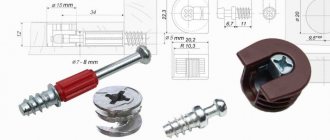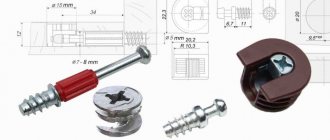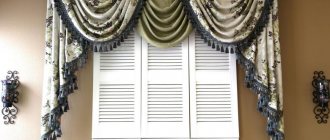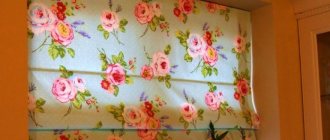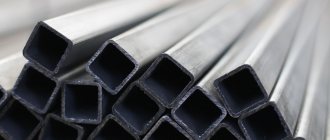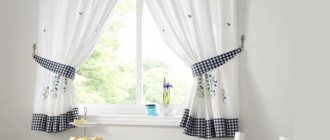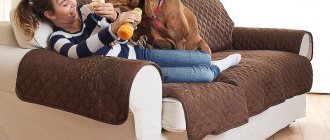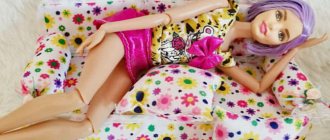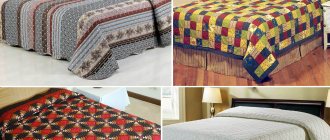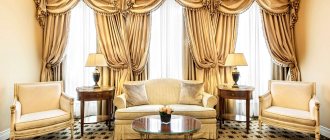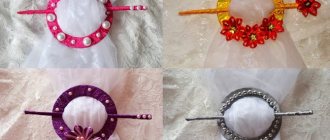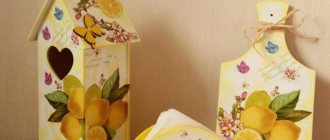Lambrequin is an elegant design element that will decorate and transform any room. Therefore, many craftswomen won’t mind learning how to sew a lambrequin with their own hands?
When creating a new interior in her room, any housewife pays great attention to the windows. It’s good when the window is designed to match the entire room. Lambrequins add a special charm to any room. But purchased products are too expensive. Therefore, many needlewomen learn to sew such products with their own hands. And I must say that they turn out no worse than store-bought ones. You just need to stock up on materials and patience for the process.
How to sew a lambrequin: what types of curtains are there?
Previously, these window decorations were made of wood. They were painted and decorated with cornices. The art improved, then they came up with new ways to cover nondescript cornices.
Types of lambrequins
Thanks to the imagination of craftswomen, lambrequins with curtains and all kinds of decorations of different types appeared. The shapes of such curtains come in different forms; today four types of these products are known.
Classic - they look like a regular strip of fabric; folds are created using tape. These lambrequins perfectly cover the imperfections that exist on the cornices and windows. The classic type of products, depending on the processing of the edges of the curtains, can be divided into the following categories:
- straight
- arched
- wavy.
Classic lambrequin
Hard lambrequins are made from fabric and a rigid frame. Thanks to the manufacturing technique, they do not change shape and their appearance is very remarkable on windows. In addition, they are decorated with special accessories that give a beautiful appearance not only to the window, but also to the room.
Curtains and hard lambrequin
Lambrequins with elements such as a mold, frill, and tie. Thanks to them, the room becomes cozy. But sewing products will require some skill; for those starting to form folds and sew them, it will be quite difficult.
Lambrequin pattern pattern for uniform - Tie
Combined lambrequins - this category has elements of a rigid type of product and ordinary fabric ones. It is better to start learning how to create lambrequins not with these types, but with simpler ones. It will take a long time to produce these interior decorations. If we divide products into types according to shape, then they can be semicircular, straight, rectangular and others (depending on your imagination).
The order of constructing the circuit - Coquille
In order for everything in the room to look harmonious, you need to carefully select the decor of curtains and lambrequins. If they match the furnishings, walls, and covering, then the room will become a subject of admiration. You yourself will enjoy spending time indoors.
Lambrequin for guest room
IMPORTANT : Carefully weigh what kind of lambrequin you want to create, decide on its size, calculate how much material is needed for it and what kind, only then make purchases.
Kinds
There are several types of lambrequins.
Simple
This is a piece of fabric that is placed into a gather on a curtain tape. It has a simple or figured bottom edge. The first option on the curtain tape is simple, the second is swag (a hanging gathering of fabric). In order to sew the first option, you need to fold and sew the bottom and side seams, and attach a textile tape to the top edge. The bottom of the product can be decorated with an arch. It is pulled together with tape and attached to the cornice. The swag option is draped in a certain way; to do this, you need to create the correct line of folds so that the fabric is even.
Soft
For this look, light flowing fabrics are used. They drape beautifully and look soft and airy. Soft lambrequins can be combined in various ways, such as frills, bells, crossovers or swags. Ruffles, ribbons or fringes are used for decoration.
Hard
For this option you need to choose a very dense fabric. It is stretched onto a frame made of wood or glued to a non-woven base. The so-called bandeau lambrequin does not have any bends or folds; it perfectly holds its shape, which can also be of different types - round, straight, curly. For decoration you can use gold embroidery, tassels, cords or flowers.
Figured
This is a beautiful decorative element reminiscent of lace. The openwork pattern can be made using a stencil and burned using laser equipment.
Combined
The combination of hard and soft types of lambrequin allows you to create original models. As a rule, they use 3 or more drapery elements. The main condition is not to overload the design with unnecessary details.
How to choose a lambrequin taking into account the characteristics of the room?
It’s difficult, of course, to decide on the style and color of the product, but you can’t do without it. Perhaps you will find an idea in fashion magazines and add something of your own to the creation of the product. Also use the following tips:
- Thanks to lambrequins, your window can decrease in size, and the ceiling height can also become visually lower. That is why designers do not recommend hanging products of this type on windows if the ceiling height is small.
- Ideally, if the fabric product covers almost the entire height of the simple area above the window itself, then the look will be complete.
- Choose the type of product depending on the characteristic features of the room. In the spacious area of the room you can create bold design ideas. And for small rooms it is better to use ordinary textile lambrequins, which are created with a small number of folds, decorations, etc.
- When selecting materials, take into account the room in which the lambrequin will hang. Always try to choose high-quality, soft, non-wrinkly fabrics.
- If the window is on the north side, then choose light, translucent materials (organza, tulle, etc.)
- On the south side you need to hang lambrequins made of dense material. The tone of the product should match the furniture upholstery and the color of the bedspread.
- To combine the delicate shades of interior colors with curtains, it is recommended to use lambrequins in bright colors.
- It is better to create rigid lambrequins from material with patterns or embroidery. The finished product is decorated with beads, ribbons, etc.
Plain blue lambrequin
What to sew from
Fashion trends extend to both lambrequins and other textile products. So, in the new season, it is preferable to opt for materials in pastel shades with a noble texture and a simple cut. Discreet and laconic decor will advantageously emphasize the elegance of flowing curtains.
For heavy, thick curtains, the following are suitable:
- jacquard;
- linen;
- cotton;
- atlas;
- plush;
- velvet.
They will add elegance and respectability to the design of the window opening.
For light and flowing curtains, the following are preferred:
- silk;
- taffeta;
- polyester;
- organza.
They will create a feeling of airiness and add grace to the interior of the room.
It is necessary to select material for curtains and lambrequins based on the style of the living space. For the living room, you can choose noble velvet or shiny jacquard; for the bedroom, linen and satin would be an excellent solution; for the kitchen, linen, cotton and polyester are ideal. These materials are practical and beautiful, especially when choosing the Provence style.
How to sew a rigid lambrequin with your own hands?
When you see a finished lambrequin for the first time, it seems impossible to make such beauty yourself. However, creating a product is not so difficult. You can make a window decoration even on a simple plywood box, because there are many devices, accessories, and decorative auxiliary materials that can be used to create a real window and room decoration.
Hard lambrequin
Materials, tools for the process:
As mentioned above, a solid frame for the product is required. It will provide the necessary rigidity and strength. This is what plywood is used for; at home you can also use plastic and something similar. After all, in construction supermarkets there are so many modern materials that can be processed with tools.
How to create a rigid lambrequin with your own hands?
For this type of curtains, dense non-woven fabrics called Shabrak, Bando are used. There is an adhesive layer on their surface. You just need to choose the material carefully, because there are different types of such fabrics (thin, with and without an adhesive base, double-sided and single-sided). You can choose the one you need yourself in a fabric store. In addition to this auxiliary textile, you will also need:
- main material for the product itself
- additional decorations, accessories, which ones - it’s up to you to choose
- threads to match the color of the main textile
- special pins for seamstresses
- ribbon (with Velcro), and of course, scissors.
If you are going to combine materials, you need a sewing machine. An iron will be needed in any case to glue the material to the rigid frame.
Start creating a rigid lambrequin with a pattern sketch on graph paper. Moreover, make a diagram of real size. So that you can then transfer it to plywood and material.
Forms of rigid lambrequins
The top of the lambrequins is usually made rectangular, and the bottom is cut out as you wish. Products can also be assembled from several parts. And these parts can overlap each other. Lambrequin parts in these cases are manufactured separately. However, now we will not talk about that; first, we will consider step by step how to make a rigid frame.
Rigid frame manufacturing process
For the classic version of a rigid lambrequin on windows, you will need 1.5 mm thick plywood. It’s good that if you cut out a hard base, your husband will help you.
Lambrequin for the hall
Next, proceed to transfer the pattern diagram onto the material. When you cut it out, take into account the allowances for the side folds. Also transfer the patterns to Shabrak and iron the base material to the frame. You can glue ribbons around the perimeter so that the ends are beautifully decorated.
On the underside of the rigid frame, install fastening materials to which the lambrequin will cling to the window.
Hard lambrequin for the hallway
This product will look even more elegant if it is decorated with appliqués, decorative cords, fringe, bells, and embroidery. For the final design of the product, drapery, strips of openwork guipure, flounces and other decoration elements are also used. Nowadays there is no shortage of this type of accessories in fabric stores.
You can make a regular hard lambrequin with your own hands without any problems. Also, come up with your own unique design for him. The main thing is to do everything slowly and carefully. After all, even small flaws on this product attract attention from afar. There is a little secret to eliminating them. To hide imperfections, you can use various decorative elements.
What is a bando
A hard lambrequin is made with your own hands on the basis of dense non-woven material. The following can be used:
- bandeau;
- interlining;
- doublerin;
- proclamin;
- wooden frame.
The first one is best. The bandeau can be self-adhesive, hot-melt, with one or two adhesive sides. May vary in density. It's convenient and easy to work with. Compared to a wooden frame, it is light in weight, and the lambrequin is easily attached to the cornice using regular Velcro tape.
How to sew a simple lambrequin with your own hands?
The production of such window decorations is carried out using various methods. Special skills are not required for this. It is better to start learning the skill of sewing lambrequins with the simplest models. To create them you don’t even need sketches of patterns. The main factor in their production will be taking into account the dimensions of the product and the external characteristics of the product. The length and width of lambrequins and curtains should be approximately calculated, as in the image below.
Ordinary lambrequin - diagram
To get the necessary product, you will need to buy material with a side width the same as the length of the lambrequin itself. To create a lambrequin with flounces, the piece of material must be almost twice as long as the width of the product itself. After measuring the required dimensions of the fabric, trim its edges to prevent fraying. Sew loops at the top of the lambrequin to secure the product to the cornice. All that remains is to add some decorative notes and that’s it, the product is ready to delight the eyes of the inhabitants of the house and their guests.
Regular lambrequin
A semi-circular pelmet looks more remarkable, especially if it is combined with gathered strips of fabric in the form of a waterfall. In addition, making a pattern of cute semicircles is not very difficult. It is enough to cut a trapezoid with equal sides and a semicircular base. Calculate sizes based on your requests. It is better to treat the bottom of the trapezoid with tape, and the sides are sewn to the main part of the lambrequin at the top. See image below.
Lambrequins for the hallway
Curtains made from strips of material in the form of waterfalls look very harmonious and solemn. It's not very difficult to do. It is enough to take a wide and long fabric and carefully gather it at equal distances so that the material hangs evenly, forming uniform waves on the surface.
Beautiful curtains with bells
For curtains, both light fabrics and dense, heavy ones are used. And it’s even better to combine them together, then you get a unique decor for the room. The edges of lambrequins are processed differently. You can simply hem it, or you can sew on ribbon, ruffles, etc. The main thing is that everything is appropriate.
Making a pattern
First, you can prepare a pattern on a small scale, and then transfer it to the fabric in the required proportions.
Lambrequin pattern with dimensions:
- For a single-section product, take a length equal to the length of the cornice.
- If the product consists of two parts, then one overlaps the other by one third.
- When choosing a three-section product, you need to perform the following calculation: the length of the rod is divided by 7 and multiplied by 3. Each section must be equal to the length of the resulting indicator. For example, the length of the cornice is 180 cm: 180:7×3=77. Each cut should be equal to 77 cm. Each element should overlap the other by 1/3.
With more elements, the folds will begin to break, and the appearance of the drapery will not be so neat.
If in the chosen model the swags do not overlap each other, then the space between them is decorated with small decorative elements - a mold (decoration from a strip of fabric cut in a spiral), ties, bells. In this way, you can hide the cords formed when the parts are pulled into folds.
Product patterns should be drawn on a wall or large table.
Product diagram
Before you start sewing or even making a pattern, draw, or better yet, draw to scale a diagram of your curtain with a rigid lambrequin. It will allow you to see how the element will look, and will also help when building a template according to size.
It is better to make the diagram on a scale of 1:10, when in 1 cm on the sheet you will have 10 cm of real ones. In this case, when creating a pattern, you can easily find out the length of any element.
Decorative finishing
Any curtains that have a rigid lambrequin (photo below) look stylish and very original due to the shape of the part. However, additional decoration will also come in handy. You can decorate the edges of the finished product as follows:
- fringe;
- braid;
- cord;
- bugles.
Usually this is done from below. The surface of the part can also be decorated with a sewn pattern from the elements listed above or use other objects, such as:
- bows;
- flowers;
- butterflies and dragonflies;
- beads;
- eyelets;
- sequins.
The choice of decor is determined by the fabric, shape and model of the lambrequin. If it is sewn from several multi-colored parts of a complex shape or the fabric has a contrasting bright pattern, additional decor will not be required.
